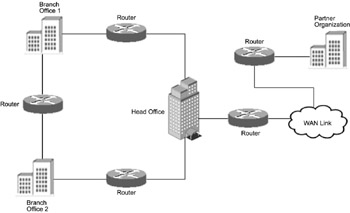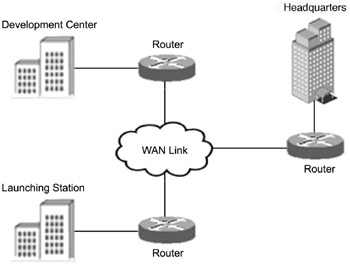Chapter 1: Introduction to Troubleshooting
![]() Download CD Content
Download CD Content
Challenges and Issues of Complex Networks
The advent of globalization has led to the need for interconnecting isolated LANs into a single network. Enterprises are now looking at sharing data and resources among hosts spread across different geographical locations. This has led to the concept of WANs, which connect an organization’s standalone LANs, located in different cities across the globe. As compared to LANs, WANs span larger geographical areas, which increases the complexity of the connected networks. In addition to WANs, wireless networks have been developed that connect multiple LANs and WANs using a satellite link.
The interconnectivity between LANs, WANs, and wireless networks has led to the development of complex networks. Thus, a complex network consists of multiple networks, connected with each other, using different types of links and a multi-protocol environment. Figure 1.1 depicts a complex network.

Figure 1.1: A complex network.
Complex networks encounter more problems than independent LANs and WANs because of their multi-protocol architecture. LANs and WANs in a complex network are connected through different protocols, such as Transmission Control Protocol/Internet Protocol (TCP/IP), Open Shortest Path First (OSPF), and Interior Gateway Routing Protocol (IGRP).
A multi-protocol architecture requires maintenance and monitoring of multiple protocols, simultaneously. Complex networks span large geographical and organizational areas, and as a result, they need to be robust and reliable. However, even the best-known technologies are prone to errors and malfunction.
Complex networks use high-end infrastructure and technology, and any kind of malfunctioning results in excessive financial and productivity losses. Therefore, troubleshooting mechanisms are required to minimize such losses. The functioning and problems of a complex network can be explained with the help of the following example.
Spacesoft Inc. is an organization that deals in research and development of aeronautical engineering. Their space shuttle launch station is located in Virginia, and the development center is located in California. In addition, Spacesoft has its spacesuite manufacturing unit at Atlanta, Georgia, which is connected with the development center and the space shuttle launch station. The three offices have individual networks that are interconnected with each other through a WAN link and Cisco 4000 series routers. Figure 1.2 displays the network architecture of Spacesoft Inc.

Figure 1.2: The network architecture of Spacesoft Inc.
Spacesoft is in the process of launching a new satellite, WAVE-series I, that will provide weather forecasts for the North American region. The Spacesoft team at the launching station is conducting last minutes checks for WAVE-series I, a report of which is being simultaneously analyzed and documented at the development center.
During this process, the WAN link between the launching station and the development center suddenly becomes nonfunctional. This renders the launching station in a noncommunicating stage until the WAN link is restored. The troubleshooting team at the launching station takes nearly 30 minutes to restore the link. After the link is restored, the development center informs the launching station that data sent 15 minutes prior to the breakdown is lost. As a result, the engineers at the launching station have to redo the checks, which delays the launching of the satellite.
A 30-minute delay results in significant financial losses to Spacesoft Inc. This motivates the management of Spacesoft to formulate a well-defined troubleshooting methodology. As a result, they are prepared for any contingency that may arise in the future.
The problem that occurred at Spacesoft is an example of the types of possible network problems and their impact. The following are some common areas in which problems may occur in complex networks, which can lead to finance and data losses:
Backbone network: Enables high-speed data transfer among hosts in a network. This backbone network consists of multiple protocols that need to be monitored constantly. Any problem in the backbone network makes the entire network nonfunctional, leading to excessive financial and productivity losses.
Transmission media: Provides data transmission services through various media, such as WANs, satellite links, infrared links, and fiber optic cables. Such links can become nonfunctional due to several reasons, such as high-level electrical interference, malfunctioning of routers, and breakdown of cables. The delay caused by nonfunctional links can be disastrous for mission-critical projects, such as space shuttle launches, online banking transactions, and telemedicine systems.
Multiple networks and multiple protocols: Enables communication and data transfer between networks. As a result, incompatibility issues within protocols can render the entire network or a part of it nonfunctional. As a result, organizations with complex networks have teams of network engineers that monitor their networks, 24/7. This ensures that any problem is identified and rectified without loss of time.
Server: Enables multiple clients to access data from a central location and provides connectivity to other servers. As a result, a nonfunctional server can render the entire or a part of the network inaccessible.
Internal and external security mechanisms: Ensure security of the data transmitted across a network. Examples of security mechanisms are firewalls, encryption techniques, and hash algorithms. Problems in the functioning of these security mechanisms also impact network performance. For example, if there is a malfunction in a hash algorithm used for encryption, the data is corrupted. A problem like this requires immediate troubleshooting, because security of data is an important factor for measuring network performance and efficiency.
Because such problems can hamper the smooth functioning of complex networks, typically organizations keep a separate team of network engineers to troubleshoot network problems.
Troubleshooting any network requires a systematic approach, because a small error in the troubleshooting process may lead to significant financial and productivity losses. To provide a systematic methodology to troubleshoot network problems, you can use the following troubleshooting approaches:
-
Cisco hierarchical approach
-
Layered approach
-
Problem resolution approach
EAN: 2147483647
Pages: 130